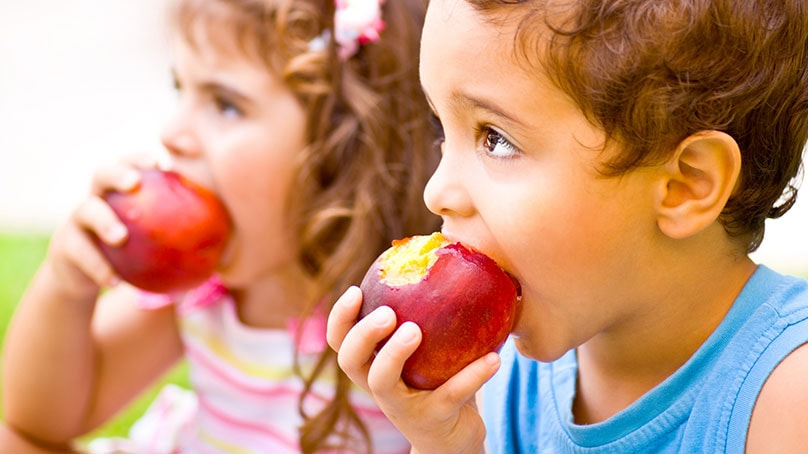 Eating Rainbow-colored Produce Adds Goodness to Health Eating Rainbow-colored Produce Adds Goodness to Health The early man survived basically on hand-picked fruits, vegetables and nuts (besides hunting down animals) before the discovery of fire. Our ancestors were one of the strongest beings who existed on Earth as they relied mostly on natural produce, pulses and grains to satisfy hunger cues. This is more than enough to reinstate the fact that eating aplenty fruits and vegetables forms the basis for a good healthy life. Even today, doctors advise patients to eat a well-balanced diet where one-half of the plate is filled with veggies and fruits only. But not one single fruit can accomplish all nutrient requirements and we need to eat a variety of colourful fruits and veggies to acquire all the goodness and nutrition of the different foods. A diet rich in fruits and veggies has the potential to lower blood pressure, reduce the risk of heart disease and stroke, prevent some types of cancer, lower risk of eye and digestive problems and also benefit blood sugar levels that in turn can keep one’s appetite in check. The choice of the fruit can also have a great impact on the benefit that you reap. For instance, non-starchy fruits such as apples, pears and green leafy vegetables might promote weight loss as these fruits have low glycemic loads that prevent blood sugar spikes (this can increase hunger levels amounting to weight gain). There are at least nine different families of fruits and vegetables each of which have hundreds of different plant compounds that are beneficial to health. What we choose and how we eat are key players in adding benefits to our body. Fruits, according to the Dietary Guidelines for America (DGA) is a nutrient-dense food that’s to be included as part of a healthy eating pattern and consuming them helps individuals balance nutrient needs with energy needs. Quantity recommendations depend on age, gender and physical activity levels: for kids it ranges from 1 cup for 2-3 years of age going up to 2 cups for males 14-18 years of age. While its suggested fresh, frozen, canned or dried fruit can be consumed to meet recommended quantities and so can 100% fruit juice my personal suggestion would always be fresh whole fruits as they are enriched in fibre content and provide maximized benefits. Almost 30-50% total fruit intake by kids aged between 9 and 18 years comes from 100% fruit juice and this has also increased their whole fruit consumption and improved overall diet quality. Despite various benefits and different forms available for consumption 75% kids aged between 9 and 13 years don’t meet recommended levels. Individuals these days lack in a number of nutrients such as fibre, potassium and vitamins, and fruits are indeed rich in all of them apart from being a rich source of phytochemicals making these foods indispensable for a healthy body. An Apple a Day Keeps Nutrition at Bay Apple is one of the commonest fruits consumed by almost everyone and it is available throughout the year irrespective of the season. One medium raw apple with skin contains 95 kcals, 19g of total sugar, 4g dietary fibre and 195 mg of potassium with almost close to zero total fat, saturated fatty acids, sodium and cholesterol. Processed apple products don’t have the same nutrient content as its raw form. For instance, apple sauce may or may not have added sugars and ½ cup has only 1.3 g of dietary fibre while 100% fruit juice contains even less-0.2 g of dietary fibre. Still, every apple product contributes towards total fruit intake through the day. Despite apples also being rich sources of phenolics, especially hydroxycinnamic acid derivatives and flavonoids not many kids love to eat this fruit regularly! Apple Peel Might Diminish Obesity Rates Most fruits are edible with their peel and we have often heard our parents insist that we eat the fruit with the peel to experience 100% nutrient value. A study by researchers at the University of Iowa shows that a natural substance found in apple peel can partially protect the mice from obesity and some of its harmful effects. According to the researchers, the study identified that a substance known as ursolic acid reduced obesity and other health problems by increasing muscle and brown fat, two tissues that are well-known for their calorie-burning properties. The study tested ursolic acid on mice on a high-fat diet and found that it increased skeletal muscle while reducing obesity, pre-diabetes and fatty liver disease. Half of the mice received ursolic acid in their high-fat food and these mice actually ate more food than mice not getting any supplements and there was no difference in activity found between the two groups. Still, the mice that received ursolic acid supplement gained less weight and blood sugar levels also remained near normal besides the fact that these mice also did not develop obesity-related fatty liver disease, a condition that affects almost 1 in 5 Americans. We know that muscle is an excellent source for burning calories and the research proves beyond that increased muscle in ursolic-acid treated mice helped in lowering obesity. Ursolic acid also increases brown fat, another excellent source to burn calories and prevent obesity. While it was believed until now that only infants had brown fat studies show that even adults have very small quantities in the neck and between shoulder blades. The current research also showed that ursolic acid consumption improved skeletal muscle (increasing endurance and strength) and quantity of brown fat. Hence, the presence of ursolic acid improves calorie burning and in turn prevents obesity, pre-diabetes and fatty liver disease, and apple peel contains this nutrient. Apple Consumption Satisfies Various Nutrient Requirements in Kids There have been no studies until now that examined the association between apple consumption and diet quality in kids and the study below examines the association between them using the National Health and Nutrition Examination Survey (NHANES). The NHANES provides information about kids in the form of interviews, dietary intake and physical examinations. The study consisted of 13,339 kids aged between 2 and 18 years who participated in the survey from 2003-2010. The participants’ consumption of apple/apple products was determined from a 24-h dietary recall that included whole apples, apple sauce (includes cooked apples), 100% apple juice and total apples (all foods from all these three apple groups). The Healthy Eating Index (HEI-2010) was used to determine diet quality score where 9 of 12 components that included fruits, vegetables, greens, beans, whole grains, dairy, total protein foods, seafood and plant proteins and fatty acids measure adequacy with higher scores while three other components including refined grains, sodium and empty calories must have higher scores as in this case, a higher score indicates lower consumption. Each of the participant’s height, weight, BMI and waist circumference was measured and kids were categorized according to results: those with a BMI value ≥85th and <95th percentile were considered overweight and kids ≥95th percentile were considered obese. The study showed that almost 26% of population consumed one or the other form of apple product, 14% consumed whole apples, 5% consumed apple sauce and almost 12% consumed 100% apple juice. Most of the children who consumed apple products were younger and less likely to be current smokers. Results showed that:
References Apple Peel Compound Boosts Brown Fat, Reduces Obesity in Mice: https://www.sciencedaily.com/releases/2012/06/120620212855.htm Consumption of Apples is Associated with Better Diet Quality & Reduced Risk of Obesity in Children: https://nutritionj.biomedcentral.com/articles/10.1186/s12937-015-0040-1 Vegetables and Fruits: https://www.hsph.harvard.edu/nutritionsource/what-should-you-eat/vegetables-and-fruits/ Comments are closed.
|
AVOID FRAUD. EAT SMART+91 7846 800 800
|
- Home
- Written Testimonials
- Consult
- Clinics
- Blogs
-
Diet & Nutrition
- Diabetes Reversal
- IVF IUI not needed for PCOS PCOD Infertility
-
Medical Nutrition
>
-
Disease & Conditions
>
- Infertility | PCOS
- Diabetes Mellitus
- Cholesterol
- Hypothyroid
- Kidney Problems
- Hypertension
- Cardiovascular Diseases
- Liver Diseases
- Gastro intestinal disorder
- Cancer
- Metabolic Disorders
- Orthopedic Disorders
- Eating Disorders
- Dietary Recall
- Weight Record Filled By Clients
- Online Payment Transaction Details
- Online Clients Weight Check Form
- Our Program Package Service Charges
- Weight Record 2017 Clients
- Measurements sent by Clients
- Terms & Conditions Of Payment
- Thanks. Your Form is Submitted
- Video Testimonials
- Lifestyle & Wellness
- Lifestyle & Wellness Blog
- Allergy & Intolerance
- Weight Loss / Gain
- Weight Loss / Slimming Blog
-
Disease & Conditions
>
- Life Cycle Nutrition >
- Sports Nutrition >
- Integrity in Nutrition
- Knowledge Centre
© COPYRIGHT 2022. ALL RIGHTS RESERVED. FRST HEALTHCARE PVT LTD.
Dr. Nafeesa Imteyaz of First Eat Right clinic, is the Best Dietitian Nutritionist in Bangalore. Best Dietitian Nutritionist in Pune. Best Dietitian Nutritionist in Hyderabad. Best Dietitian Nutritionist in Chennai. Best Dietitian Nutritionist in Mumbai. Best Dietitian Nutritionist in Delhi. Best Dietitian Nutritionist in Kolkata.



